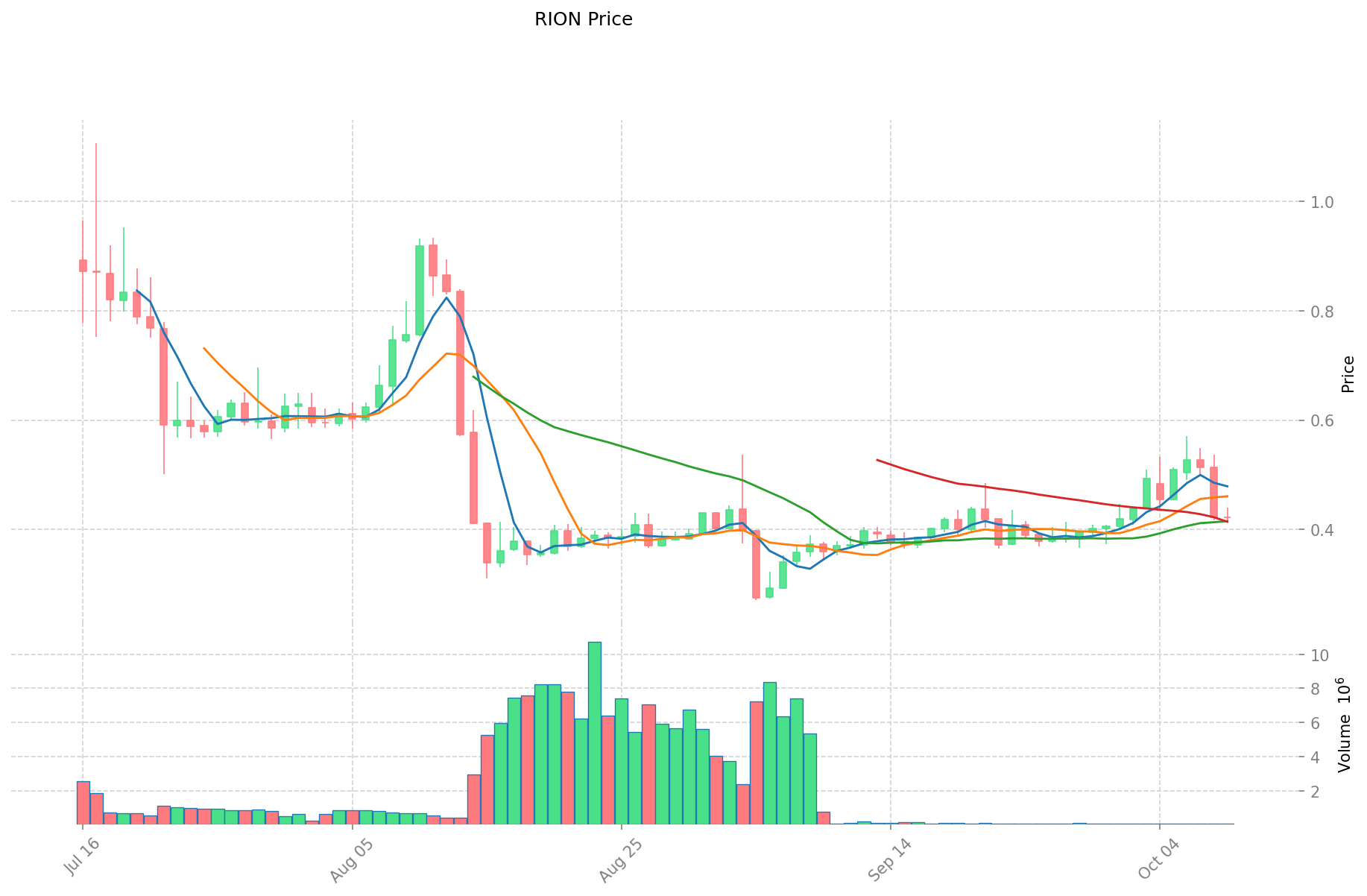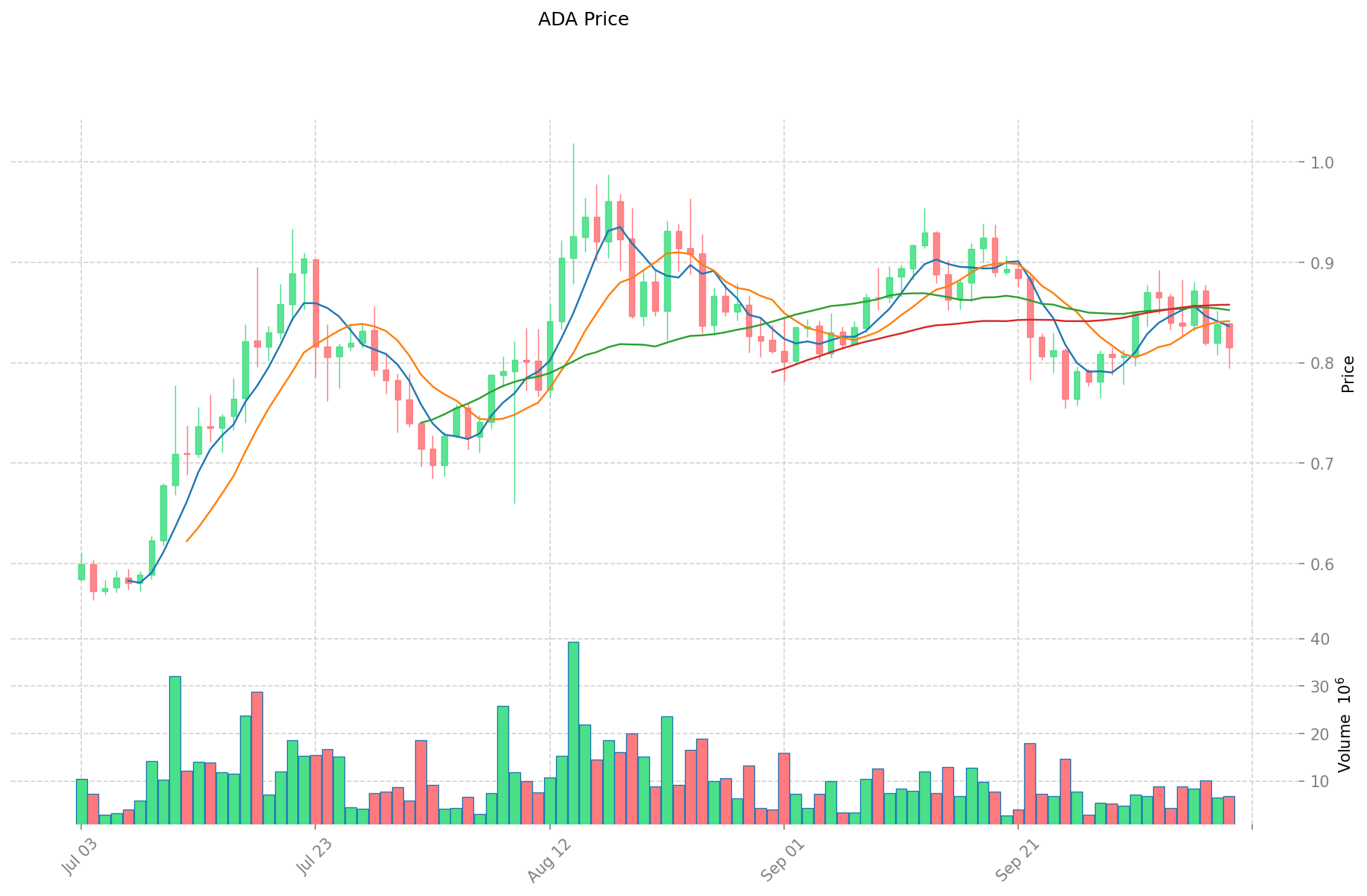RION vs ADA: The Battle for AI Supremacy in Natural Language Processing
Introduction: RION vs ADA Investment Comparison
In the cryptocurrency market, the comparison between Hyperion (RION) and Cardano (ADA) remains an unavoidable topic for investors. The two not only show significant differences in market cap ranking, application scenarios, and price performance but also represent different positioning in crypto assets.
Hyperion (RION): Since its launch, it has gained market recognition as the leading DEX on Aptos, ranking among the top 12 DEXs globally by trading volume.
Cardano (ADA): Introduced in 2017, it has been hailed as a technology platform capable of running financial applications used by individuals, organizations, and governments worldwide.
This article will comprehensively analyze the investment value comparison between RION and ADA, focusing on historical price trends, supply mechanisms, institutional adoption, technological ecosystems, and future predictions, attempting to answer the question investors are most concerned about:
"Which is the better buy right now?"
I. Price History Comparison and Current Market Status
RION (Coin A) and ADA (Coin B) Historical Price Trends
- 2025: RION reached its all-time high of $1.1064 on July 17, 2025, before declining to its all-time low of $0.2704 on September 4, 2025.
- 2021: ADA hit its all-time high of $3.09 on September 2, 2021, during the broader cryptocurrency bull market.
- Comparative analysis: In recent market cycles, RION has shown significant volatility, swinging from $1.1064 to $0.2704 within a short period in 2025. ADA, on the other hand, has demonstrated long-term resilience, rising from its all-time low of $0.01925275 in March 2020 to its current price level.
Current Market Situation (2025-10-10)
- RION current price: $0.4219
- ADA current price: $0.8163
- 24-hour trading volume: $23,403.32 (RION) vs $5,559,566.67 (ADA)
- Market Sentiment Index (Fear & Greed Index): 70 (Greed)
Click to view real-time prices:
- Check RION's current price Market Price
- Check ADA's current price Market Price


II. Core Factors Affecting the Investment Value of RION vs ADA
Supply Mechanism Comparison (Tokenomics)
- RION: Limited total supply of 435 million tokens with no inflation mechanism
- ADA: Fixed supply cap of 45 billion ADA tokens with no further issuance
- 📌 Historical pattern: Limited supply tokenomics typically support long-term price appreciation when demand increases, though both assets follow this model with different total supply caps.
Institutional Adoption and Market Applications
- Institutional holdings: ADA has more established institutional presence through Grayscale's Cardano Trust and inclusion in various crypto indices
- Enterprise adoption: ADA has deeper integration with businesses through Cardano's enterprise solutions while RION's adoption remains at an earlier stage
- National policies: Both face similar regulatory scrutiny across jurisdictions with neither having significant regulatory advantages
Technical Development and Ecosystem Building
- RION technical upgrades: Integration with Solana-based wallets and planned support for future cross-chain functionality
- ADA technical development: Continuous improvement through Cardano's peer-reviewed development approach and phased roadmap implementation
- Ecosystem comparison: ADA has a more mature ecosystem with established DeFi protocols, NFT marketplaces and smart contract functionality; RION's ecosystem is still developing with focus on gaming and entertainment applications
Macroeconomic Factors and Market Cycles
- Performance in inflationary environments: Both assets position themselves as inflation hedges, though neither has a long enough track record to fully validate these claims
- Macroeconomic monetary policy: Both are affected similarly by interest rate decisions and dollar strength, with risk-on assets generally struggling during monetary tightening
- Geopolitical factors: Cross-border transaction demand benefits both networks, with Cardano having more established presence in developing markets
III. 2025-2030 Price Prediction: RION vs ADA
Short-term Prediction (2025)
- RION: Conservative $0.31-$0.43 | Optimistic $0.43-$0.56
- ADA: Conservative $0.62-$0.82 | Optimistic $0.82-$0.91
Mid-term Prediction (2027)
- RION may enter a growth phase, with estimated prices $0.30-$0.79
- ADA may enter a steady growth phase, with estimated prices $0.71-$1.18
- Key drivers: Institutional capital inflow, ETF, ecosystem development
Long-term Prediction (2030)
- RION: Base scenario $0.61-$0.76 | Optimistic scenario $0.76-$0.86
- ADA: Base scenario $1.27-$1.48 | Optimistic scenario $1.48-$1.60
Disclaimer: This analysis is based on historical data and current market trends. Cryptocurrency markets are highly volatile and subject to change. This information should not be considered as financial advice. Always conduct your own research before making investment decisions.
RION:
| 年份 | 预测最高价 | 预测平均价格 | 预测最低价 | 涨跌幅 |
|---|---|---|---|---|
| 2025 | 0.55926 | 0.4302 | 0.314046 | 1 |
| 2026 | 0.5689395 | 0.49473 | 0.4650462 | 17 |
| 2027 | 0.78711543 | 0.53183475 | 0.3031458075 | 25 |
| 2028 | 0.7122330972 | 0.65947509 | 0.6396908373 | 56 |
| 2029 | 0.829883453256 | 0.6858540936 | 0.370361210544 | 62 |
| 2030 | 0.86397040170792 | 0.757868773428 | 0.6062950187424 | 79 |
ADA:
| 年份 | 预测最高价 | 预测平均价格 | 预测最低价 | 涨跌幅 |
|---|---|---|---|---|
| 2025 | 0.906315 | 0.8165 | 0.62054 | 0 |
| 2026 | 1.05091715 | 0.8614075 | 0.680511925 | 5 |
| 2027 | 1.17607965975 | 0.956162325 | 0.7075601205 | 17 |
| 2028 | 1.3859572900875 | 1.066120992375 | 0.92752526336625 | 30 |
| 2029 | 1.728715189136062 | 1.22603914123125 | 0.772404658975687 | 50 |
| 2030 | 1.595567338398348 | 1.477377165183656 | 1.270544362057944 | 81 |
IV. Investment Strategy Comparison: RION vs ADA
Long-term vs Short-term Investment Strategy
- RION: Suitable for investors focused on DEX ecosystems and potential cross-chain functionality
- ADA: Suitable for investors seeking established blockchain platforms with smart contract capabilities
Risk Management and Asset Allocation
- Conservative investors: RION: 20% vs ADA: 80%
- Aggressive investors: RION: 40% vs ADA: 60%
- Hedging tools: Stablecoin allocation, options, cross-currency portfolios
V. Potential Risk Comparison
Market Risk
- RION: Higher volatility due to smaller market cap and newer market presence
- ADA: Susceptible to broader crypto market trends and competition from other smart contract platforms
Technical Risk
- RION: Scalability, network stability, and cross-chain integration challenges
- ADA: Smart contract vulnerabilities, network congestion during high-traffic periods
Regulatory Risk
- Global regulatory policies may impact both, with ADA potentially facing more scrutiny due to its larger market presence and wider adoption
VI. Conclusion: Which Is the Better Buy?
📌 Investment Value Summary:
- RION advantages: Leading DEX on Aptos, potential for high growth in emerging blockchain ecosystem
- ADA advantages: Established platform, peer-reviewed development approach, mature ecosystem
✅ Investment Advice:
- Novice investors: Consider a higher allocation to ADA for its established presence and ecosystem
- Experienced investors: Balanced approach with exposure to both RION and ADA based on risk tolerance
- Institutional investors: Consider ADA for its institutional-grade infrastructure and liquidity, while monitoring RION for potential growth opportunities
⚠️ Risk Warning: Cryptocurrency markets are highly volatile. This article does not constitute investment advice. None
VII. FAQ
Q1: What are the main differences between RION and ADA? A: RION is a newer token focusing on DEX functionality on the Aptos blockchain, while ADA is an established platform with smart contract capabilities and a more mature ecosystem. RION has a smaller market cap and higher volatility, whereas ADA has broader institutional adoption and a more extensive development history.
Q2: Which cryptocurrency has shown better price performance recently? A: Based on the provided data, RION has shown higher volatility with significant price swings in 2025, reaching an all-time high of $1.1064 before dropping to $0.2704. ADA has demonstrated more long-term stability, maintaining a higher price point at $0.8163 as of October 10, 2025.
Q3: How do the supply mechanisms of RION and ADA compare? A: Both RION and ADA have limited supply mechanisms. RION has a total supply cap of 435 million tokens, while ADA has a fixed supply cap of 45 billion tokens. Neither has an inflation mechanism, which typically supports long-term price appreciation when demand increases.
Q4: What are the key factors affecting the investment value of RION and ADA? A: Key factors include supply mechanisms, institutional adoption, market applications, technical development, ecosystem building, macroeconomic factors, and market cycles. ADA generally has more established presence in these areas, while RION is still developing its ecosystem and market position.
Q5: What are the predicted price ranges for RION and ADA in 2030? A: According to the provided predictions, RION's price range for 2030 is estimated at $0.61-$0.86, with a base scenario of $0.61-$0.76 and an optimistic scenario of $0.76-$0.86. For ADA, the 2030 price range is estimated at $1.27-$1.60, with a base scenario of $1.27-$1.48 and an optimistic scenario of $1.48-$1.60.
Q6: How should investors approach allocating between RION and ADA? A: The allocation depends on an investor's risk tolerance. Conservative investors might consider allocating 20% to RION and 80% to ADA, while more aggressive investors might opt for 40% RION and 60% ADA. Novice investors may prefer a higher allocation to ADA for its established presence, while experienced investors might take a more balanced approach.
Q7: What are the main risks associated with investing in RION and ADA? A: Both face market risks, technical risks, and regulatory risks. RION has higher volatility and faces challenges in scalability and cross-chain integration. ADA is susceptible to broader crypto market trends and potential smart contract vulnerabilities. Both may be impacted by global regulatory policies, with ADA potentially facing more scrutiny due to its larger market presence.
Share
Content